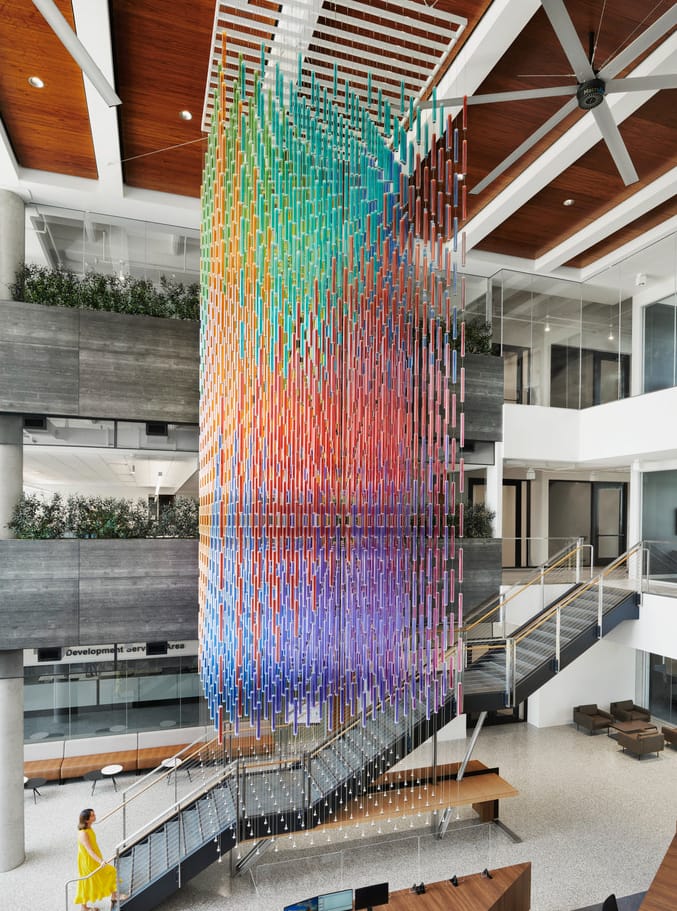By Dan Cheetham | Managing Principal
The profitable property is an occupied property, a place where organizations flourish and people want to be. But post-pandemic occupancy is down with many professionals reluctant to return to the office, opting instead for the convenience of home, be it ever so humble. But why? How has the office missed the mark as a desirable destination when it potentially offers opportunity for human interaction, collaboration, and comradery, which most of us admittedly seek, as well as technology advantages and amenities? Certainly, a constellation of reasons can be cited, but more importantly, how do we inspire enthusiasm for the office as a vibrant, sought-after destination?
Looking back, the office historically started out as a less than attractive proposition—a sterile environment purposefully designed to create separation and encourage hierarchy. Emphasizing the employer’s power and prestige, each employee did their work in a field of regimented workstations, punctuated by the occasional office signaling that one amongst them was destined for greater things. The skyscraper itself was intended to intimidate, demonstrating the might of the organization that could afford to build it.
Although we’ve made great strides since then in workplace design and dynamics, the pandemic has propelled a long overdue reset, playing into trends focused on work-life harmony, equity, and human-centric values already in motion pre-pandemic. Times have changed. And part of the reset involves an attitude towards work that calls for engagement, relationships, wellbeing, and…joy. These are reasonable demands since we know that once our needs for safety and sustenance are met, we look for community, meaning, and beauty—findings explicated and celebrated by Abraham Maslow. These three factors when designed into the office building experience as a destination will help attract and sustain users. Creating a profitable property means creating experiences for human engagement that enable opportunities for community, meaning, and beauty.
COMMUNITY
Magical sparks fly in spaces where serendipitous, chance encounters are encouraged. Establishing a framework to support these experiences helps drive a sense of community. By blurring the boundaries between public and private spaces, a building extends its presence and appeal well beyond its physical space. Connecting building users to the local context outside the property’s boundaries establishes a wide sense of community. Overlapping private and public experiences set the stage for rich encounters and a vibrancy that distinguishes the building as a destination. Bringing together users and locals through options for food and services, as well as events, art, and culture reinforces the property’s persona and brand.
MEANING
Meaning is communicated through purpose, the intention to create a sense of happening, vitality, and community for shared experiences within the property and its perimeters. And there are additional benefits, because play and joy, essential for wellbeing, lay the groundwork for innovation, so important in today’s competitive marketplace.
While cultivating user and public appeal and interest, a property can also nurture personal meaning through opportunities for individual explorations and experiences—maybe meditation and sensory gardens or walking paths—that speak to users on an visceral level, build connection to the property and an understanding of the part the user plays within the whole.
BEAUTY
An experience of beauty opens up the flow of our creativity, making way for our best output. The inclusion of artwork, not as decoration but as part of a more immersive experience, elevates our senses, creative powers, and feelings of belonging. Furthermore, an emphasis on biophilia and movement towards more organic forms, materials, and sustainability will inspire a synergy with nature. Environments can be sculpted like artwork or layered like a musical composition with features that engage the senses. Immersive aesthetic environments that promote comfort, function, engagement, equality, and community are magnets for users. These spaces attract attention; combined with events and services tailored to the building’s brand and local culture they rouse user support and loyalty.
HOW?
Opening the property for tenants and the community can take many forms depending on intent, the building’s physical footprint and architectural configuration, and brand. From transforming the street appeal/use and lobby into a powerful statement that affects the entire neighborhood, to distinguishing the lobby or exterior with a strong aesthetic statement to leveraging the unexpected—an alleyway as a joyful community venue—all are possibilities with different objectives, scope, and budget for transforming the property into an impactful, alluring destination connecting a variety of users on multiple levels. Curating opportunities for enjoyment and interaction, capturing the imagination, inspiring sharing via features and events with individual and universal appeal can transform the property to a sought-after destination/venue where people want to be for both work and play.
To put it simply, as a basic premise, the building as a destination that connects with and inspires today’s users—who look to it for engagement, community, meaning, aesthetic appeal, and a sense of wellbeing beyond their job and professional commitments—exponentially increases its value, presence, occupancy, and profitability.
Dan Cheetham | Managing Principal
With over 30 years of architecture experience, Dan Cheetham is the Founder and Managing Principal of FYOOG, an IA Interior Architects Company, and is known for his unlikely creative process that weaves architectural concepts and artistic influences. His vision for FYOOG is a result of his coveted industry experience, his passion as a musician, and his collaborations with artists and artisans. Dan has led firms, projects and teams across the world on highly visible projects that have taken many forms, including large urban districts and plans, commercial and institutional projects, educational buildings and settings, as well as outdoor spaces, temporary installations, and sculptures. He is a an AIA, NCARB, LEED AP BD+C accredited professional with a BA in Architecture and Music Performance.




